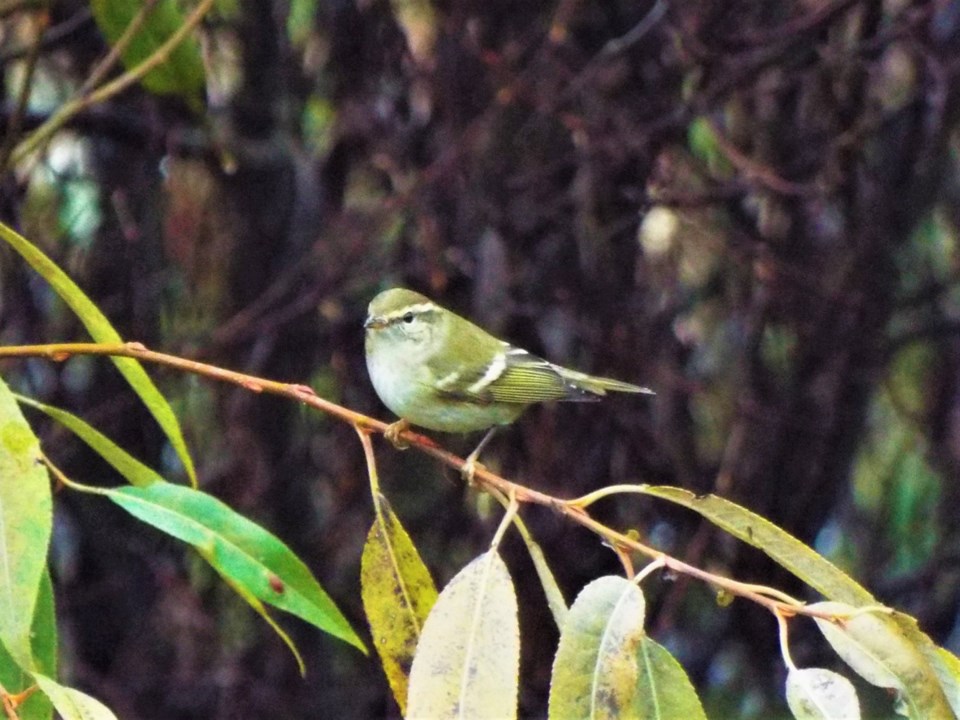Birding enthusiasts were aflutter in Saanich’s Panama Flats Saturday morning hoping to catch a glimpse of a rare warbler never before seen in Canada.
Upwards of 50 people flocked to the park with binoculars around their necks and telephoto lenses at the ready for a shot of the yellow-browed warbler. Some came from the Lower Mainland, Washington State and even California, though none travelled quite as far as the bird, which is a migrant from Asia.
The migratory warbler typically spends its winters in the tropical climates of South Asia and Southeast Asia, and sometimes in Western Europe.
The bird was spotted Friday afternoon about 4 p.m. by local birders Jeff Gaskin and Geoffrey Newell, who called the sighting a “mega-rarity.” It was the first time the yellow-browed warbler had been seen in Canada, and only the second time in North America, excluding the islands off of western Alaska.
“First glimpse, I knew it was something very rare. I knew it was a bird that wasn’t from North America,” Newell said.
“I was jumping up and down. It was so exciting.”
Newell posted the sighting to a few birding websites, alerting the local community. Within half an hour, more than 20 people joined Newell and Gaskin to view the bird, he said. If the warbler sticks around, Newell expects people will travel from across North America for a chance to see the rare warbler.
Newell, a 24-year-old local birder who has been birding for two-thirds of his life, sent photos of the warbler to several experts in Vancouver, who were able to confirm that it was a yellow-browed warbler.
Melissa Hafting, who runs B.C. Rare Bird Alert, was one of those Newell turned to for help identifying the bird. Hafting compared the photos Newell sent her with images in her field guide to confirm the species.
“It’s very exciting,” she said. “It’s gone worldwide that people know this bird is here in the birding community.”
Daniel Donnecke was teaching a chemistry lab at Camosun College Friday afternoon when he heard about the sighting.
He finished the lab, jumped on his bike and raced to Panama Flats, only to miss the bird by five minutes. By 8 a.m. Saturday, he was back in the park, eyes scanning for movement in the trees.
His effort paid off. Donnecke estimated he was one of about 100 people who saw the warbler Saturday morning. In Victoria’s birding community, that’s a big crowd. Donnecke said an unusual sighting normally draws about 10 people.
“This is a really exciting time. I mean the warbler is fanastic. Absolutely exciting, but now we’re having some really high-calibre birders here. They’re coming from all over the place to see this bird,” he said.
Donnecke hopes the presence of so many birders will lead to more sightings of rare birds.
Among those who hopped on a ferry after hearing about the record sighting was John Reynolds.
“It’s nice to come out and see something new,” Reynolds said, who came over Saturday morning from Vancouver.
He hadn’t seen the warbler yet, but said he was enjoying the opportunity to connect with the birding community.
“It’s sort of like a little reunion whenever this happens,” he said.
Reynolds was out with Brian Starzomski, who saw the bird briefly earlier in the day.
“Someone said ‘I hear it,’ so everybody dashed up onto the dyke and was peering into the forest,” he said. “It was deep into the foliage so you could just barely see it, and hear it calling.”
Newell said it’s likely the bird was on its first migration and got lost. “This is a bird that breeds across Russia and Siberia and many winter in Southeast Asia. So this bird accidentally went down the wrong coast,” he said.
Newell isn’t sure whether the bird will survive after flying so far off course.
“Hopefully, the bird will find its way back to Siberia,” he said.



